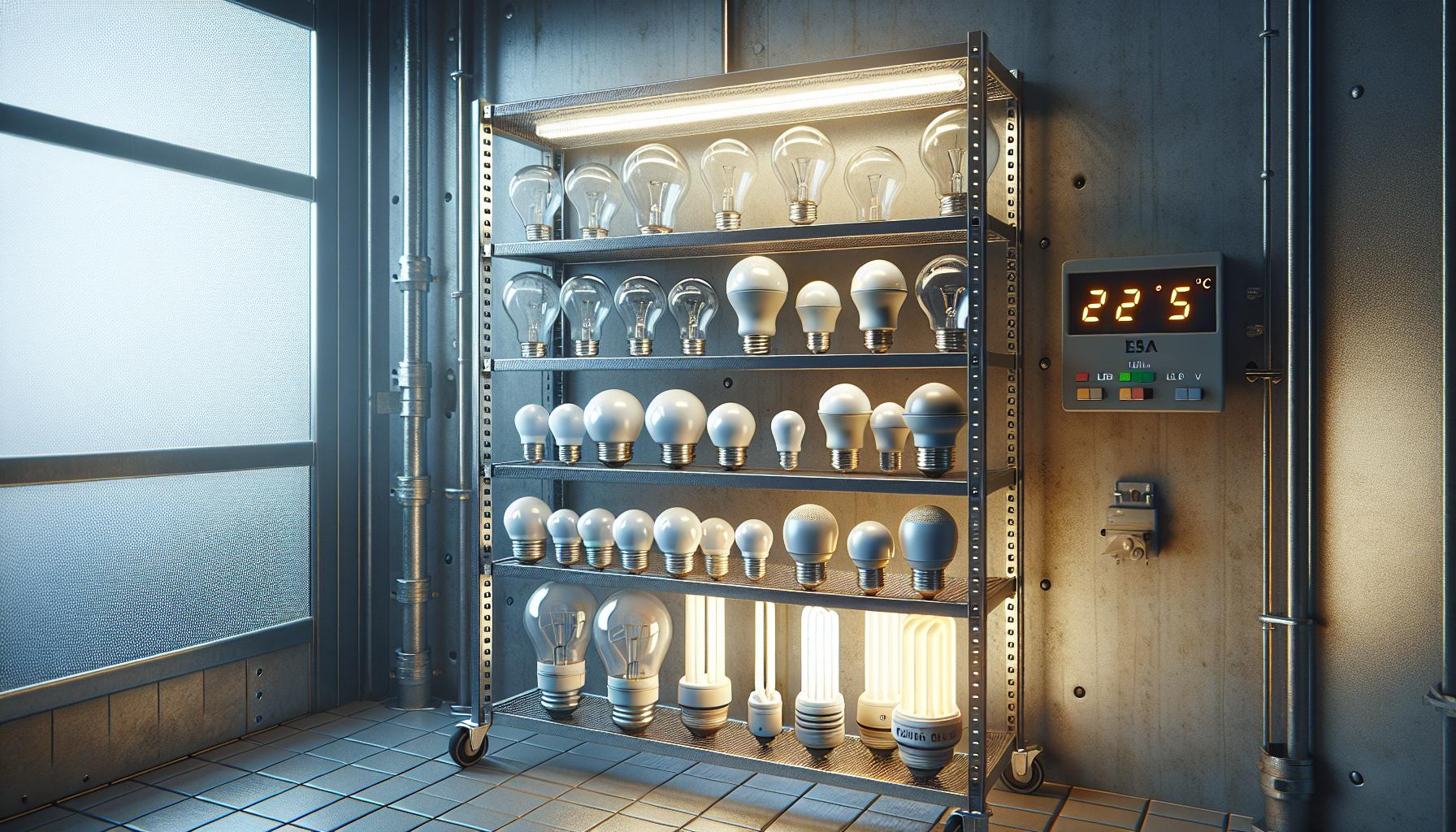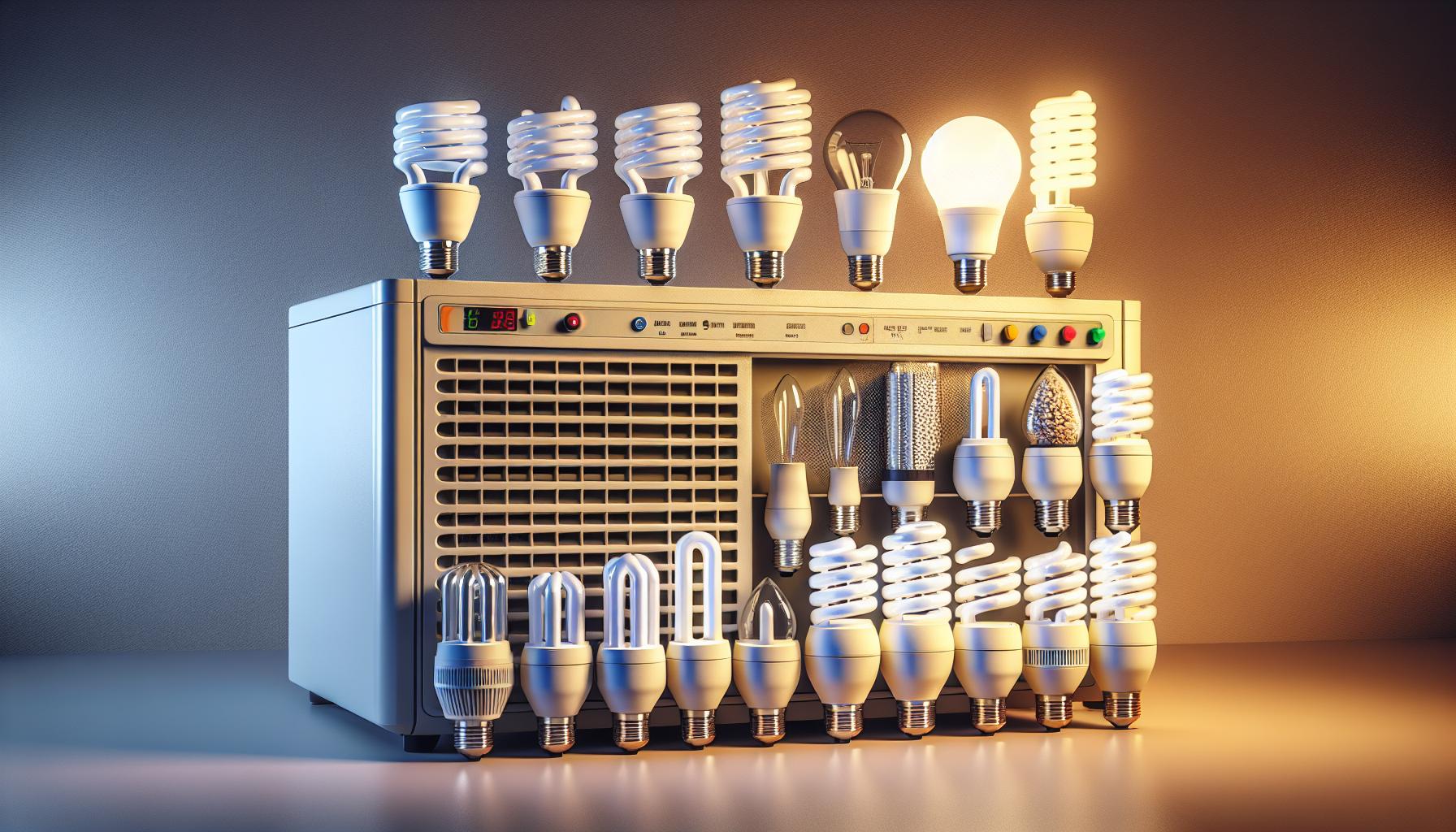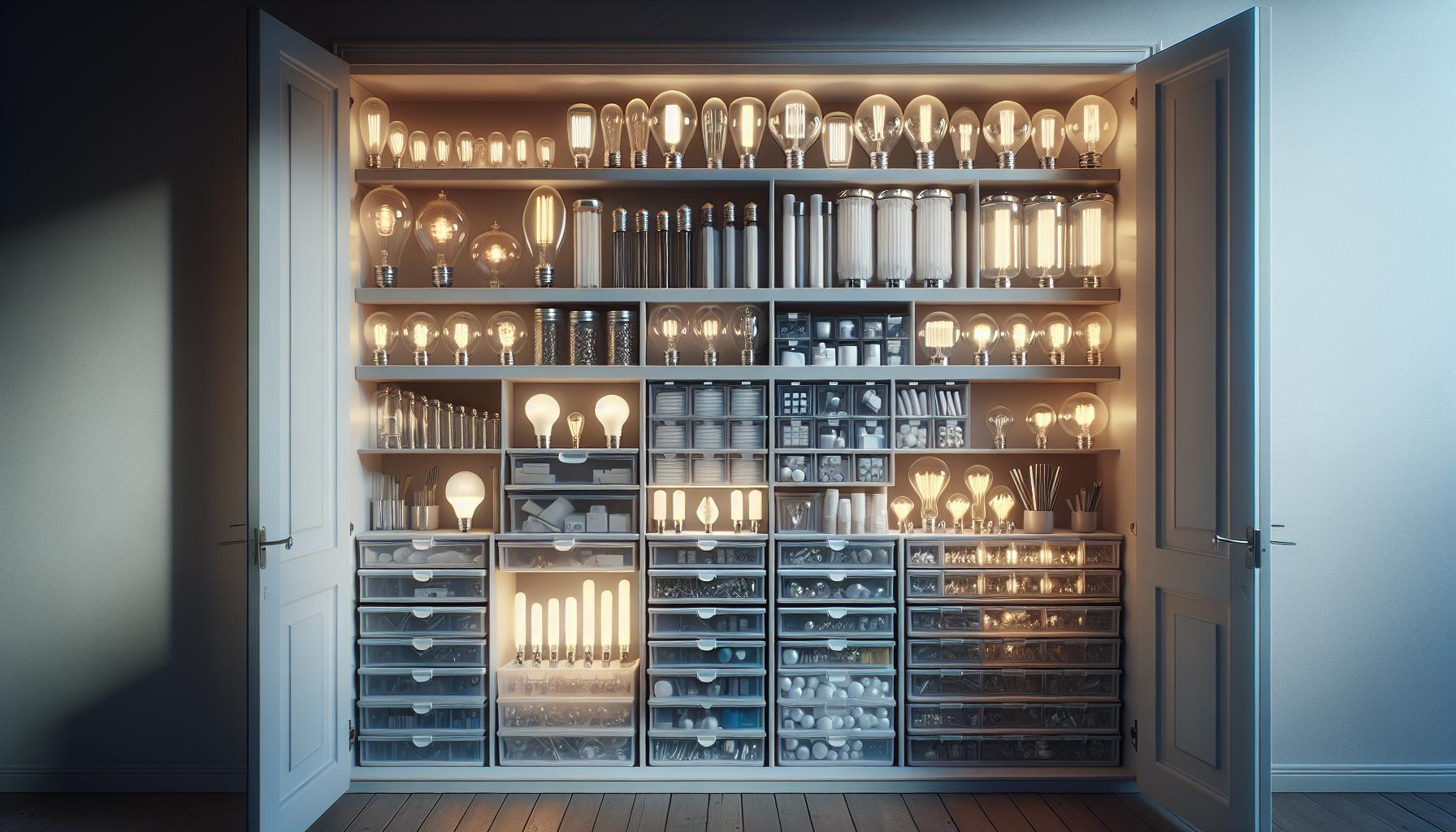Ever wondered if your sweltering garage is a safe spot for those extra light bulbs? You’re not alone. Storing anything in a hot garage comes with its challenges, and light bulbs are no exception.
You might think they’re just glass and metal – how sensitive can they be? Well, before you stash your bulbs next to the lawn mower and summer sports gear, let’s shed some light on the dos and don’ts of light bulb storage.
Temperature swings and humidity are big concerns, and they could mean the difference between a bright idea and a dim disappointment. Stick around to find out if your garage is bulb-friendly or if you need to rethink your storage strategy.
Why Storing Light Bulbs in a Hot Garage is a Concern
When you’re diving into your DIY projects, there’s nothing more frustrating than finding out your supplies aren’t in good shape. Light bulbs, for instance, might seem like they could handle the rugged environment of a hot garage, but that’s not the case. Temperature fluctuations and high heat can seriously impair their performance.
Incandescent bulbs, for example, have a delicate filament that can warp or break when subjected to extreme conditions. Let’s not forget CFLs (Compact Fluorescent Lamps) and LEDs (Light Emitting Diodes) which have electronic components that heat can damage. High temperatures can reduce the lifespan of these bulbs or cause them to fail prematurely. This means that the money you thought you were saving by buying in bulk may actually be going to waste if your storage is compromising the bulbs.
Here’s a breakdown of how temperature affects different types of light bulbs:
| Bulb Type | Ideal Storage Temperature |
|---|---|
| Incandescent | Below 80°F (27°C) |
| CFL | Below 90°F (32°C) |
| LED | Below 100°F (38°C) |
Keep in mind that the garage isn’t just hot; it’s often humid too. Humidity can wreak havoc on the metal components of light bulbs, leading to corrosion and failures. It’s a sneaky culprit, often overlooked, yet it shortens the lifespan of your bulbs as surely as the heat does.
Storing light bulbs in a well-ventilated and climate-controlled space inside your home is more likely to preserve their integrity. You’ve put time into selecting just the right lighting for your space – don’t let a hot garage undo all your hard work.
Think about alternative storage solutions inside your home. Empty drawers, closets, or even under the bed provide cooler environments that can keep light bulbs in prime working order. Your lighting is an important aspect of your home’s ambiance and functionality, so give it the care it deserves by storing it properly.
Remember, even if your garage seems like the easiest spot, when it comes to light bulbs, the coolest place is the best place to be. Keep this in mind next time you’re shopping for those extra bulbs on sale – it might be wise to clear out a space indoors rather than risk the garage’s unpredictable conditions.
The Effect of Temperature on Light Bulbs
Imagine a summer day, the sun beats down on your garage, and inside, the temperature soars. Your light bulbs, tucked away in a box on a shelf, are enduring a silent struggle. You see, temperature extremes, especially heat, wield a great influence over the lifespan and performance of various types of light bulbs. Just like you, they prefer a comfortable living environment.
Incandescent bulbs are particularly susceptible to heat. Inside each bulb, a delicate filament glows hot to produce light. But when the ambient temperature rises, it can shorten the life of these filaments significantly. As an enthusiast of home DIY projects, you’ll appreciate that maintaining the optimal conditions for such components is crucial.
CFLs (Compact Fluorescent Lamps) aren’t fans of the heat either. They depend on a mixture of gases and a tiny amount of mercury vapor to produce light. High temperatures can cause these elements to behave unpredictably, sometimes reducing the efficiency of the chemical reaction that lights up your room. The ballast, a component in CFLs, is also heat-sensitive; excessive warmth can lead to its early demise.
« How Big is Light Bulbs: Unveil Perfect Sizes for Your Space
Why Are LED Light Bulbs More Efficient? Uncover the Shocking Lifespan & Eco Benefits »
LEDs (Light Emitting Diodes) are often heralded for their durability and long life. However, they have a hidden vulnerability—their drivers. These electronic components manage the power input, and when pushed beyond their thermal comfort zone, they can fail prematurely. High heat can also affect the phosphor coating inside LEDs, altering the quality of light over time.
Let’s put this into perspective with some numbers.
| Type | Optimal Temperature Range (°F) |
|---|---|
| Incandescent | 50 – 70 |
| CFL | 60 – 80 |
| LED | 60 – 85 |
Note: These ranges are a general guideline; individual product specifications may vary.
Whether you’re a lighting connoisseur or a weekend warrior turning houses into homes, understanding how temperature affects your light bulbs is instrumental in ensuring they keep shining bright. It reinforces the idea of finding a spot for them indoors:
- Air-conditioned spaces
- Away from windows where direct sunlight can sneak in
- Storage areas with stable temperature
The Effect of Humidity on Light Bulbs
When you’re tackling home DIY projects, understanding the nuances of lighting can be crucial. Humidity often gets overlooked, yet it’s a significant factor that affects the performance and lifespan of your light bulbs. Like temperature, excessive humidity can create an unwelcoming environment for all types of light bulbs.
High humidity conditions, particularly when combined with high temperatures, can lead to condensation within the bulb. This is problematic because moisture inside the bulb can cause a short circuit, leading to failure or even a potential fire hazard. In areas with high humidity levels, this can happen frequently, especially when the bulb is turned off and cools rapidly, allowing moisture from the air to condense on the inside of the glass.
For incandescent bulbs, the issue of humidity is less pronounced as their internal operation involves generating heat, which typically keeps moisture at bay. However, other types of bulbs like CFLs and LEDs are more susceptible to humidity:
- CFLs can suffer from reduced performance since the electronic components inside the ballast are sensitive to moisture.
- LEDs are also prone to damage as humidity can corrode the electrical components and lead to irreversible failures.
Here’s what you can do to ensure the longevity of your bulbs in humid conditions:
- Make use of dehumidifiers or air conditioners in spaces where you store or use your light bulbs.
- Ensure good air circulation around stored bulbs to minimize the risk of condensation.
- Consider weather-rated bulbs for areas that experience high humidity levels, such as garages or outdoor fixtures.
Protecting your bulbs from humidity is a subtle yet significant step in maintaining optimal operation. Regularly checking the storage area for signs of moisture and ensuring adequate air movement can save you the headache of premature bulb failures. Remember, the integrity of your bulbs is not just about the immediate brightness but also about their resilience to environmental factors over time.
Proper Storage Tips for Light Bulbs
When stowing away your light bulbs in a place like a hot garage, you’ll want to keep a few key tips in mind to maintain their efficiency and extend their lifespan. Heat can significantly reduce a bulb’s performance, so it’s essential to be strategic about where and how you store your spare lighting.
Firstly, consider the packaging. Always store bulbs in their original packaging or a suitable alternative that provides similar protection. This not only guards against physical damage but also minimizes exposure to temperature extremes. Cardboard boxes are perfect as they offer insulation from heat and prevent bulbs from knocking into one another and potentially breaking.
Next up, location is everything. You’re aiming to find a spot that remains as cool as possible, away from windows where direct sunlight can turn your storage area into a mini greenhouse. A cabinet or shelf that’s not exposed to the main heat flow from the garage’s air can make all the difference.
Another vital element is humidity control. We’ve touched on the havoc that excessive moisture can wreak on bulbs. Pairing a storage spot away from the warmth with silica gel packs or a small dehumidifier will help to suck out any unwanted dampness, safeguarding your bulbs from an untimely demise.
If your garage experiences temperature fluctuations, it’s well worth investing in weather-rated bulbs. These bulbs are specifically designed to withstand less-than-ideal conditions and will typically fare better than their standard counterparts in a storage environment challenged by higher temperatures.
Lastly, clever ventilation can be a lifesaver—figuratively speaking, of course. Ensure your storage area has ample airflow; this may involve rearranging items or drilling a few holes for circulation. Good airflow will help to dissipate heat and keep your bulbs at a relatively stable temperature. Plus, it’s a great way to wick away moisture naturally.
By keeping these tips in mind, you’re doing more than just storing light bulbs; you’re taking a proactive approach to preserving your lighting investments. Your future self will thank you when you reach for that next bulb and find it’s as good as the day you bought it.
Alternative Storage Options for Light Bulbs
So, your garage gets hot, and you’re concerned it might not be the best spot for your light bulbs. No worries, you’ve got plenty of other options for storing those bright beauties safely.
Inside Your Home
The simplest alternative is inside your home. Closets, drawers, or cabinets make excellent storage spaces, especially if they’re out of direct sunlight and away from high moisture areas. It’s generally cooler and drier, which is just what you’re after.
- Closets: Tuck your bulbs in a shoebox and slide them onto a closet shelf. It’s out of the way and in a climate-controlled environment.
- Drawers: Wrap individual bulbs in bubble wrap or keep them in their original packaging and nestle them into a drawer. This keeps them padded and protected.
- Cabinets: Perfect for bulkier items or larger quantities. Stack boxes on a shelf, keeping heavier items on the bottom.
Climate-Controlled Units
If you’re a DIY aficionado with an extensive collection of specialty bulbs, it may be worth investing in a climate-controlled unit. This keeps them at a consistent temperature and humidity level.
- Choose a Small Unit: You likely don’t need much space, so a small unit will do.
- Consider Location: Pick a spot that’s easily accessible but not prone to extreme temperature changes.
Repurposed Furniture
Get creative with unused furniture. An old dresser or file cabinet can become your dedicated bulb storage. Plus, it’s an eco-friendly solution.
- Seal the Deals: Make sure drawers or doors close tightly to protect against dust and moisture.
- Label Everything: Clear labelling saves time when you’re hunting for the right bulb.
Remember, where you store your bulbs is just as crucial as how you store them. By choosing a storage method that shields your bulbs from heat and humidity, you’ll be sure to keep them shining bright and ready for when you need them. Keep them in a controlled environment, and you’ll save yourself the hassle of premature replacements.
Conclusion
So you’ve got the scoop on keeping your light bulbs in tip-top shape. Remember, the key is to shield them from the extremes of heat and humidity. Whether you tuck them away in a closet or get creative with repurposed furniture, you’re now equipped to extend the life and efficiency of your bulbs. It’s all about finding that cool, dry spot where they can wait in comfort for their time to shine. Happy storing!
Frequently Asked Questions
What are suitable indoor storage options for light bulbs?
Closets, drawers, or cabinets within the home serve as suitable storage options for light bulbs. These locations generally provide a stable environment, sheltering bulbs from excessive heat and humidity.
Can light bulbs be stored in climate-controlled units?
Yes, climate-controlled units are excellent for storing light bulbs as they maintain a constant temperature and humidity level, which helps in preserving the bulbs’ efficiency and lifespan.
Why is it important to protect light bulbs from heat and humidity?
Protecting light bulbs from heat and humidity is crucial because exposure to these elements can reduce the efficiency of the bulbs and shorten their operational lifespan. A stable environment ensures optimal performance and longevity.
Is repurposing furniture a good way to store light bulbs?
Repurposing old furniture, such as cabinets or dressers, is a creative and effective way to store light bulbs. It allows for organization and protection from potentially damaging environmental conditions.





